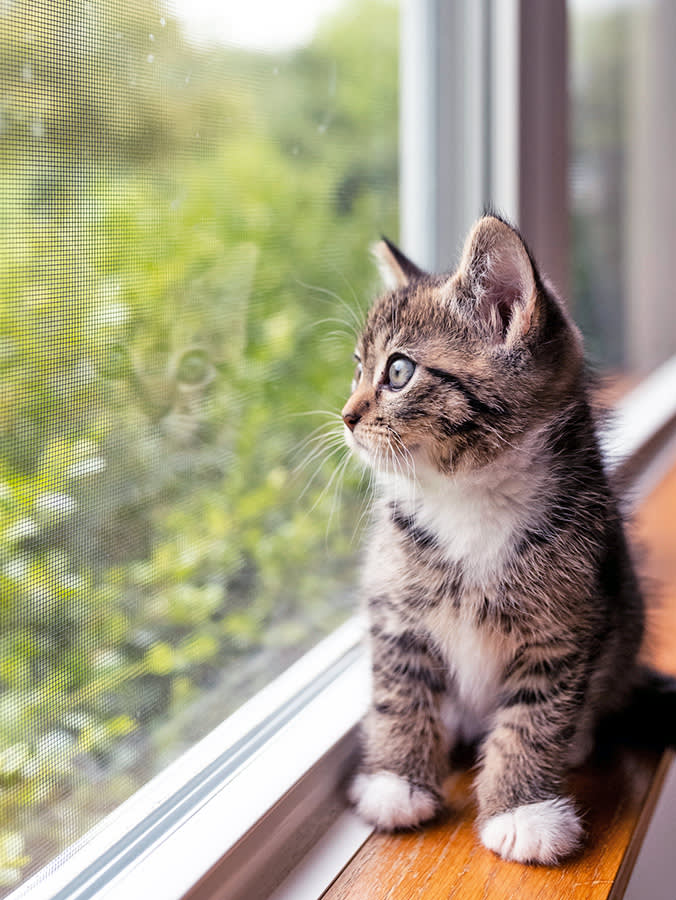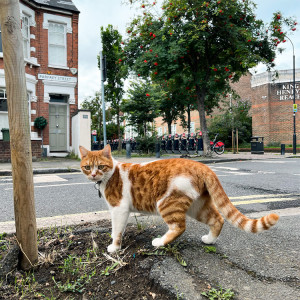When Can My Kitten Go Outside in the UK?
If you’d like your kitten to grow up with outdoor access, here’s what to know to help keep them safe
While there’s probably always going to be a debate over whether it’s best for cats to have outside access or stay indoors, it’s much more common for cats to be allowed outdoors in the UK than in some countries – like the US and Canada. In fact, International Cat Care estimates that just 10 percent of cats in the UK are kept indoorsopens in new tab.
If you do choose to let your kitty venture outdoors, do you know what age can your cat can go outside or what should you consider before opening the back door? From the required vaccines to the risks, here’s everything to know so we can keep our kitties safe both in and out of the home.
Main takeaways
Kittens can go outside from about four months old, once they’ve had their vaccines, been microchipped, been neutered, and begun flea and worm treatment.
Make sure your kitten is comfortable inside the home before you let them out – you want them to return happily.
It’s best to supervise your kitten at first, and bring a reward with you so you can call them over if you need to.
There are risks that come with having an outdoor cat, from road accidents to poisonous garden chemicals, so make sure safety comes into your decision.
How old should my kitten be to go outside?
You could take your kitten outside with supervision from the age of about four months, or a little before, providing they’ve been neutered and have had all their vaccinations. “Cats are prone to potential infections so it’s vital they’re fully vaccinated,” explains registered veterinary nurse and pet behaviour specialist Zoe Blakeopens in new tab. “Wait at least a week after the course has finished so that would take them to approximately 13–14 weeks depending on vaccine type.”
Meanwhile, it’s best to make sure your kitten has fully settled into the home first, and appears confident indoors, before you let them outside.
If you’re concerned that they could get away from you, there’s no harm in waiting until they’re a little older and larger – perhaps five or six months old – and it’s best to wait until around this time before you let them out unsupervised, too. Just as you wouldn’t leave a young kitten home alone for a long time, it’s best not to leave them outdoors by themselves for a little while yet, either.
Preparing to let your kitten go outside
Before you let your kitten explore the outdoors, it’s best to ensure that they’re fully prepared. Not only will this keep them safe, and will help put your own mind at rest, too.
Make sure they’re comfortable indoors first
You don’t want to rush or overwhelm your cat. There’s nothing wrong with being patient and taking your time, and you want to make sure that your kitten will happily return back indoors once they’ve been outside. The desire to explore is an important kitten behaviour milestone to be aware of – but as nice as it is to see them explore their world, you’ll want them back indoors safely.
Get all necessary vaccines
Your kitten should complete their vaccination course – and let their immune system process it – before they’re allowed outside. If not, your cat is at risk of catching some serious diseases from other felines.
Microchip your cat
In June 2024, a law making microchipping compulsory came into law in England, but getting your cat microchipped is strongly recommended wherever you reside in the UK. With a microchip, identifying your cat becomes much easier.
Introduce a worm and flea treatment
While indoor cats can get fleas and worms, an outdoor cat will be more susceptible. You can usually begin treatment for kittens between 8–12 weeks old, so it’s best to ensure you’re on the same page with the breeder or rescue.
Buy an ID tag
While a microchip is a must, an ID tag will also help your cat be identified. Include your phone number, and if space, a backup number, your kitty’s name, an address or postcode, or important medical information. This way, if someone finds your cat, they can get them back to you more easily.
Wait until the kitten is neutered
It’s best to wait until your kitten is neutered before you let them outside – it’s not a myth. Usually, they’ll need to be at least four months old and over a certain weight. Unneutered female kittens can get pregnant from around four months old, while unneutered male kittens can develop the desire to wander, which could prove dangerous.
Introducing your kitten to outside
Introducing your kitten to the outdoors for the first time can be an exciting moment, but how can you make it a great one for both of you? Zoe advises choosing a quieter time – perhaps when your neighbours are at work and school.
At first, it’s best to go with your cat rather than leave them unsupervised. Leave the door open so your cat’s able to head back inside if they’d like to, too – it could be too cold for cats, particularly kittens, or they might be finished with exploring sooner than you expect.
Bring a reward with you, such as a favourite toy or some treats, and call them back to you if you’re worried they’re going too far. “Learning a recall is not just for our dog companions – cats can be trained, too,” explains Zoe. Something she suggests is letting your cat out when they’re hungry and leaving the door open.
“After 5–10 minutes, call them in and offer a high-reward treat, something really enticing,” she says. “You could then repeat this a few times before calling them in and offering a meal. Stop, and repeat the next day. You may be happy repeating this daily, and once you feel the kitten has the hang of coming back, you can start to let them out a few times a day.”
As your cat begins to seem more comfortable and relaxed with being outside, you can let them come and go as they please. You might consider installing a cat flap so they aren’t waiting for you to let them in and out.
Risks of letting your kitten outside
Cats with outdoor access will encounter risks that indoor cats won’t. “You need to consider the area that you live and what risks may be – urban areas will naturally carry more risk than countryside living,” says Zoe, who highlights potential run-ins with foxes as one issue that might crop up in city life.
Sadly, many cats are killed or injured by vehicles on the road each year, with young cats often the victims. As many accidents happen at night, it can be a good idea to call your kitty in when it gets dark. It’s also worth keeping the temperature in mind – it can get colder at night, particularly in the winter months, while in those summer days it’s important to keep your cat cool and prevent heat-stroke.
Fighting is another risk to be aware of – as parents of multiple cats can likely attest, cats don’t always get on. While neutering will minimise much of the risk here, it’s still possible that your cat could get into scrapes. Meanwhile, cats can also be at risk of catching diseases and picking up parasites, which is why vaccines and flea and worm treatments are so important.
And kittens can go missing. A small kitten who hides in a garage for shelter from the rain could get locked in, or a cat snoozing outside could be mistaken for a stray and fed or handed into an animal charity by a well-meaning member of the public.
“Ensure that you have explored your garden and checked that any potential hazards are removed or covered,” says Zoe. One of the most serious potential risks is that of poison, however. If your cat comes into contact with common poisons such as slug pellets, anti-freeze, or pesticides, it’s important to get them to the vet as soon as possible as they can cause ill health and even death.
Likewise, some garden plants can be toxic, with lilies being a major culprit. If you can, it’s a good idea to create a cat-safe garden to reduce the risk, but, of course, you can’t control what your neighbours do, and be sure to block any holes that your kitten could escape through.
Outdoor kittens: frequently asked questions
When can kittens go outside for the first time?
There’s no hard-and-fast rule, but generally, a kitten can go outside when they’re around four months old – this is often when they’ll have been neutered, vaccinated and microchipped. If you need or want to hold off a little while, that’s fine.
When can a kitten be left alone outside?
It’s best to gradually build up the amount of time your kitten spends outside before you leave them out there alone, and ensure that they’re comfortable and confident with being outdoors. From six months, it’s something you might want to think about, but again, it’s fine to hold off.
When can I move kittens outside?
While your kitten can probably go outside from the age of about four months, it’s not advisable for them to remain outside due to the risks they can face. If you’d like your cat to have outdoor access, it’s best for them to be able to come inside as they please.
References
Foreman-Worsley, Rachel, et al. “Indoors or Outdoors? An International Exploration of Owner Demographics and Decision Making Associated with Lifestyle of Pet Catsopens in new tab.” MDPI, Multidisciplinary Digital Publishing Institute, 20 Jan. 2021.
“Indoor and Outdoor Catsopens in new tab.” Cats Protection. Accessed 3 Jan. 2025.
“Keeping Cats Safe Outside: Help & Advice: Cats Protectionopens in new tab.” Keeping Cats Safe Outside | Help & Advice | Cats Protection, www.cats.org.uk/help-and-advice/home-and-environment/keeping-cats-safe-outside. Accessed 3 Jan. 2025.









